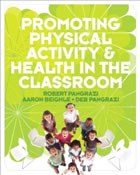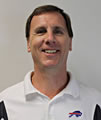EDITORIAL
New
Horizons Ahead for PE Professionals in 2013
If you are among the approximately 13,000
member supporters of the National Association
for Sport and Physical Education (NASPE),
news from the Charlotte National AAHPERD Convention
will interest you. Voting delegates at the
convention approved plans to make AAHPERD
a unified professional association replacing
the existing five separate and independent
national associations.
On the minds of many physical educators were
questions such as "What exactly does
this mean for the programs, products, and
services presently delivered by NASPE?"
and "Who's going to be responsible for
physical education into the future?"
In view of NASPE's longstanding professional
leadership, uncertainty about where this transition
is headed is unsettling. As this new professional
organization begins to reform itself and navigate
new waters, it faces many challenges. Not
unreasonably we might ask, "Why take
this risk?"
|
PRESS
RELEASE on Dr.
Steve Jefferies's recent recognition
at the AAHPERD national convention this
past week in Charlotte.
Submitted
by Sinu A. Patel, M.A.
Communications Associate,
AAHPERD & NASPE
|
Unfortunately, it's pretty clear there's
no easy alternative. There's no safe way forward.
In fact the trends are alarming. Professional
associations of all types are facing financial
and membership crises. As publishers of printed
media know well, the explosion of access to
free information has changed the communication
landscape. Today, people are reluctant to
pay for anything and even less inclined to
pay membership dues to groups that don't clearly
meet their needs. Going forward, a critical
challenge facing the new AAHPERD leadership
is trying to identify what exactly physical
educators want.
Since the 1960s when AAHPERD membership totaled
over 50,000, fewer and fewer physical educators
have been willing to support a national professional
association. Embarrassingly, less than 5%
of the health and physical education teachers
nationwide are professional members. Not surprisingly,
it's becoming harder and harder to effectively
defend against program and position cuts or
to advocate to legislators the importance
of K-12 physical education. With non-membership
the norm, our professional association simply
doesn't have sufficient funding, personnel,
or political clout to counter the tendency
to focus on so-called core competences in
our public schools.
For far too long K-12 physical educators
have endured a lack of respect from teaching
colleagues and school administrators. Getting
no respect is for many PE teachers the norm.
And so it was exciting to hear at this year's
convention the opening of a unique and time-sensitive
window of opportunity for the physical education
profession to recreate itself. What now remains
to be seen is whether we will be imaginative
or insightful enough to take it?
If you haven't heard, a new initiative called
Let's
Move, Active Schools was just announced.
It's a huge collaborative effort to bring
back physical activity into the nation's schools.
Announced by First Lady Michelle Obama, and
with a $50 million five-year funding commitment
by Nike, Let’s
Move, Active Schools will be managed
by the President's Council on Fitness, Sports
& Nutrition (PCFSN), the Alliance for
a Healthier Generation, and our very own AAHPERD.
This initiative gives physical educators
a chance to establish themselves as leaders
in school physical activity promotion. But
to do so is going to take a speedy reimagining
of the profession. If we fail and continue
thinking of ourselves as "gym teachers"
(depressingly labeled after the name of the
room in which we teach), it will be a lost
opportunity that could potentially lead to
the demise of the profession. And with the
Obamas in the White House for only three more
years, the time for change is now.
The problem is that if the nation's economic
problems persist and the pressures of academic
accountability increase, physical education
classes will continue to be squeezed from
the curriculum. Embracing the Let's
Move, Active Schools initiative gives
us a chance to establish ourselves at the
core of the school experience. More and more
evidence – if more were needed in addition
to common sense – is pointing to the
connection between health and academic performance.
And if that wasn't enough, worries about the
spiraling health care costs of the consequences
of sedentary living are likely to spur even
the most cost-conscious legislators to support
school physical activity promotion. But who's
going to lead this bold initiative?
It's pretty obvious that the best-qualified
individuals to promote school-wide physical
activity are physical education teachers.
Less certain is whether we will be willing
and motivated to work out how we can do this,
as well as teach physical education classes.
But the consequences of failing should alarm
us. This is a call to action. Already, physical
education programs around the country have
been cut and replaced with physical activity.
Is there a difference? Apparently not in the
minds of many school administrators. Many
have discovered that hiring physical activity
instructors is a whole lot cheaper than professional
physical educators.
But today – and for a limited time
only – we have a chance to straighten
the record. Physical activity is important.
In fact, it's a huge measure of a successful
PE program. What kids choose to do when they
are not in our classes is significant. If
they choose physical activity, we should celebrate
that they are on the road toward healthy and
active future lives. But starting them on
this path depends on preparing them with the
skills and knowledge they'll need to be competent
and confident movers. This is our chance to
show the public that physical education provides
children with the foundation to counter sedentary
living. And this moment may not come again.
Somehow physical educators have to step up
and to do more. Carpe
diem! Let's seize the day. The job responsibilities we anticipated when entering the profession weren't a guaranteed lifetime contract. They have to change, and we with them. Failing to adapt to the changing
21st century school environment is a gamble
with extinction. One thing is certain. If
we don't take responsibility for school-wide
physical activity promotion, someone else
will.
For the physical education profession there
will be no do-overs. Physical educators will
become increasingly isolated and marginalized
in their gymnasiums, and the profession will
continue its decline. Pretty predictable will
be the emergence of a new school physical
activity promotion profession. Private enterprise
is probably already licking its lips and mobilizing.
With Nike's involvement in Let's
Move, Active Schools, heeding the
company's "Just Do It" slogan has
special significance today for the physical
education profession.
So this year as AAHPERD transitions itself
into a more focused professional association,
it's going to be a period of challenge and
change. All of us have roles to play.
Certainly it's incredibly shortsighted for us not to become member supporters of our professional association (tell your colleagues). K-12 physical educators and those preparing future teachers need to personally support and get our colleagues involved in initiatives such as Let's
Move, Active Schools.
It would truly
be sad to look back on 2013 as the year of
missed opportunities when collectively we
could have solidified physical education's
status as central to K-12 public education,
but instead failed to act.
Steve
Jefferies, publisher pelinks4u
|
















